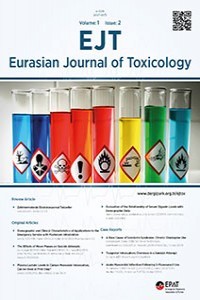
Eurasian Journal of Toxicology
Yazarlar: Sinem DOĞRUYOL, İlker AKBAŞ, Erdal TEKİN
Konular:Acil Tıp
Anahtar Kelimeler:Carboxyhemoglobin,Carbon monoxide,Lactate,Poisoning
Özet: Objectives: The aim of this study was to determine whether there was a significant relationship between carboxyhemoglobin levels and plasma lactate levels at the time of admission in patients who had been admitted to the emergency department due to carbon monoxide intoxication. Materials ad Methods: In this retrospective-cross-sectional study, patients diagnosed with toxic effects of carbon monoxide were evaluated among the patients admitted to the emergency department between 01.01.2013-01.01.2017. Blood gas data obtained from the peripheral artery in the first 30 minutes of patients’ admission to the emergency department were examined. Patients were classified as Group 1 (10% -20%) and Group 2 (20% and above) according to their carboxyhemoglobin levels. Results: A total of 404 patients were included in the study. The mean carboxyhemoglobin level was 21.2 ± 8% for all cases and 14.6 ± 3% for Group 1 and 27.8 ± 6% for Group 2. The difference between the two groups was statistically significant (mean difference 13.2; 95% CI = 12,198-14,157) (p <0.001). The number of patients with lactate levels above normal in Group 2 was higher than Group 1 (p <0.001). There was a significant difference in lactate levels between two exposure groups (p <0.001). At the same time, when all parameters were evaluated, there was a correlation between carboxyhemoglobin levels and lactate levels (r = 0,601, p <0,001). In the ROC analysis to determine the value of lactate levels in the diagnosis of severe exposure (Group 2), AUC was calculated as 0,791 (95% confidence interval, 0.748-0.835; p <0.001; Figure 1). The positive predictive value for lactate level 3 mmol/L was 88% and the negative predictive value was 63% and this level could be used as cut-off value. Conclusion: In the evaluation of cases of carbon monoxide poisoning, the question of whether plasma lactate level can be used as a marker is still being discussed. Based on the significant results that we found in our study, plasma lactate levels ,which is correlated with carboxyhemoglobin levels, may be helpful in the classification and evaluation of patients with carbon monoxide intoxication.